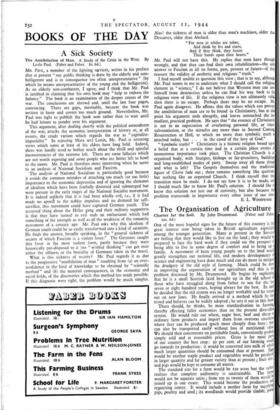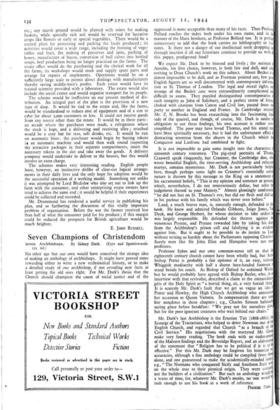The Organisation of Agriculture
Charter for the Soil. By John Drummond. (Faber add Faber.
nos. 6d.) ONE of the most hopeful signs for the future of this country is the great interest now being taken in British agriculture especially among the younger generation. Many at present in the Services are feeling that they would like to live on the land; they would be prepared to face the hard work if they could see the prospect cl being able to live in some degree of comfort and to bring up I family. A movement of keen young people on to the land would greatly strengthen our national life, and modern developments el science and engineering have done much and can do more to mitigate the drudgery of the old style of fanning. Much could be done in improving the organisation of our agriculture and this is the problem discussed by Mr. Drummond. He begins by explaining that he is a small Scottish laird brought up in the old school el those who have struggled along from father to son for the last seven or eight hundred years, hoping always for the best. In 1921 he decided that the old system was no longer workable and he struck out on new lines. He finally arrived at a method which he its tested and believes can be widely adopted ; he sets it out in this boat There should, he thinks, be more standardisation in farming thereby effecting fuller economies than on the present diversified system. He would rule out wheat, sugar beet, beef and sheep as ordinary farm products and import them from overseas countries where they can be produced tpuch more cheaply than here ; tlie! can also be transported easily without loss of nutritional value. We should then concentrate on perishable foods, conveniently packed, simply sold and at reasonkble prices. Grass is for most Pans of our country the best crop : 50 per cent, of our farming would go towards its production : it would be converted into milk of wind much larger quantities should be consumed than at present. Eggs would be another staple product and vegetables would be produced in larger quantity and far greater Variety than at present ; fruit also; and pigs would be kept to consume all wastes. The standard size for a farm would be 150 acres but the auth$ realises that complete uniformity is unattainable. The fa"i would not be separate units • from ten to twenty of them would be, joined up in one estate. This would become the production 315 organising centre. It would include a mother farm fox sup011'il pigs, poultry and seed ; its woodlands would provide timbtr, Posts'
etc.- any marsh ground would be planted with osiers for making baskets, while specially rich soil would be reserved for 'lucrative crops like flowers or early or special vegetables. There would be a central plant for processing and packing the foods produced ; its activities would cover a wide range, including the freezing of vege- tables and fruit, the making of preserves and jams, packing of honey, manufacture of bacon, conversion of bull calves into bottled soups, beef production being no longer practised on the farms. The estate office would do the purchasing and the clerical work for all the farms, its workshops Would stock and supply spare parts and arrange for repairs of implements. Operations would be on a sufficiently large scale to permit direct dealings with manufacturers thereby saving middle-men's profits. Each estate would have its trained scientist provided with a laboratory. The estate would also include the social centre and would organise transport for its people.
The scheme would be ineffective on our present method of dis- tribution. An integral part of the plan is the provision of a new type of shop. It would be tied to the estate and, like the farms,. would be standardised to reduce cost of equipment and of a size to cater for about 3,000 customers or less. It could not receive goods from any source other than the estate. It would be in three parts : an arcade where the purchases were made, a refrigerator where the stock is kept, and a• delivering and receiving alley ; attached would be a cosy bar for teas, soft drinks, etc. It would be run on automatic lines : the purchaser would begin by buying tokens i4 an automatic machine and would then walk round inspecting the attractive packages in their separate compartments, insert the necessary tokens in the slot and take away the .goods. A delivery company would undertake to deliver to the houses, but this would involve an extra charge.
The schemes makes very interesting reading. English people have, however, an instinctive dislike of clear-cut logical arrange- ments in their daily lives and the only hope for adoption would be the successful operation of a working model. Something not unlike it was attempted by Lord Bledisloe who also set out to link up the farm with the consumer, and other enterprising estate owners have tried to achieve the same end ; it would be helpful if their experiences could be collected and recorded.
Mr. Drummond has rendered a useful service in publishing his plan, and so furthering the discussion of this vitally important problem of organisation. Before the war the farmer received less than half of what the consumer paid for his produce ; if this margin could be reduced the prospects for British agriculture would be much brighter.
E. JOHN RUSSELL.



























 Previous page
Previous page